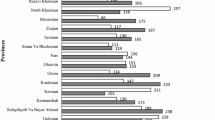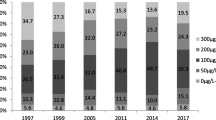Abstract
Objectives: To evaluate the current nationwide iodine status in Turkey by determining urinary iodine concentrations (UIC) and household salt iodine content. A follow-up monitoring study was also conducted in 30 urban areas. Methods: A school-based survey was conducted in 2007 by using multistage ‘proportionate to population size’ (PPS) cluster sampling method. The study population was composed of 900 school-age children (SAC) from different urban, suburban, and rural areas. UIC and iodine content of the table salt used at home were analyzed. Results: Median UIC was 107 μg/l (147 in urban, 42 in suburban and rural areas, p<0.001). There were severe iodine deficiency (ID) in 7.2%, moderate and mild ID in 20.6% and 19.3%, of the SAC, respectively. UIC was sufficient (>100 μg/l) in 50% of the study population, whereas it was excessive (>300 μg/l) in 10.5% of them. Of the 900 salt samples, 662 (73.5%) were iodized and 508 samples (56.5%) contained adequately iodized salt (iodine content >15 ppm). UIC of the study population and salt iodine levels correlated well (r=0.42, p<0.001). Conclusions: Moderate to severe ID still exists in 27.8% of the Turkish population, which is much better compared to 1997 and 2002 surveys (i.e. 58%, 38.9%, respectively). The follow-up monitoring study (in 2007) demonstrated that ID has been eliminated in 20 of 30 cities surveyed, and median UIC was 130 μg/l. ID has been eliminated in most of the urban population, however, it is still an important problem in rural areas and in particular geographical regions, which should be the target of future programs.
Similar content being viewed by others
References
Zimmermann MB. The impact of iodised salt or iodine supplements on iodine status during pregnancy, lactation and infancy. Public Health Nutr 2007, 10: 1584–95.
de Benoist B, McLean E, Andersson M, Rogers L Iodine deficiency in 2007: global progress since 2003. Food Nutr Bull 2008, 29: 195–202.
WHO, UNICEF, ICCIDD. Assesment of Iodine Deficiency Disorders and Monitoring their Elimination. A guide for programme managers, 3rd edition. Geneva, World Health Organization 2007.
Hetzel BS. Iodine deficiency disorders (IDD) and their eradication. Lancet 1983, 2: 1126–9.
Dunn JT. What’s happening to our iodine? J Clin Endocrinol Metab 1998, 83: 3398–400.
Iodine requirements in pregnancy and infancy. ICCIDD IDD Newsletter 2007, 23: 1–2.
Zimmermann MB, Hess SY, Adou P, Toresanni T, Wegmüller R, Hurrell RF. Thyroid size and goiter prevalence after introduction of iodized salt: a 5-y prospective study in schoolchildren in Cote d’Ivoire. Am J Clin Nutr 2003, 77: 663–7.
De Benoist B, Andersson M, Egli I, Takkouche B, Allen H. Iodine status worldwide, WHO Global Database on Iodine Deficiency. Department of Nutrition for Health and Development World Health Organization Geneva 2004, 1-16.
Erdogan G, Erdogan MF, Emral R, et al. Iodine status and goiter prevalence in Turkey before mandatory iodization. J Endocrinol Invest 2002, 25: 224–8.
Erdogan G, Erdogan MF, Haznedaroglu D, et al. Improving Iodine Status in Turkey. 29th Annual Meeting of European Thyroid Association, ICCIDD Satellite Meeting, Edinburgh, UK, 2003 (Abstract).
Cetin H, Kisioglu AN, Gursoy A, Bilaloglu E, Ayata A. Iodine deficiency and goiter prevalence in Turkey after mandatory iodization. J Endocrinol Invest 2006, 29: 714–8.
Darcan S, Unak P, Yalman O, et al. Determination of iodine concentration in urine by isotope dilution analysis and thyroid volume of school children in the west coast of Turkey after mandatory salt iodization. Clin Endocrinol 2005, 63: 543–8.
Simsek E, Safak A, Yavuz O, Aras S, Dogan S, Kocabay K. Sensitivity of iodine deficiency indicators and iodine status in Turkey. J Pediatr Endocrinol Metab 2003, 16: 197–202.
Erdoğan MF, Demir O, Emral R, Kamel AN, Erdoğan G. More than a decade of iodine prophylaxis is needed to eradicate goiter among school age children in a moderately iodine-deficient region. Thyroid 2009, 19: 265–8.
Bürgi H, Schaffner TH, Seiler J P. The toxicology of iodate: a review of the literature. Thyroid 2001, 11: 449–56.
Venkatesh Mannar MG, Dunn JT. Salt iodization for the elimination of iodine deficiency. Netherlands, International Council for Control of Iodine Deficiency Disorders, 1995.
Darnton-Hill I, Webb P, Harvey PW, et al. Micronutrient deficiencies and gender: social and economic costs. Am J Clin Nutr 2005, 81: 1198S–205.
Progress against widespread iodine deficiency in Europe. ICCIDD IDD Newsletter 2008, 29: 1-14.
Author information
Authors and Affiliations
Corresponding author
Rights and permissions
About this article
Cite this article
Erdoğan, M.F., Ağbaht, K., Altunsu, T. et al. Current iodine status In Turkey. J Endocrinol Invest 32, 617–622 (2009). https://doi.org/10.1007/BF03346519
Accepted:
Published:
Issue Date:
DOI: https://doi.org/10.1007/BF03346519




